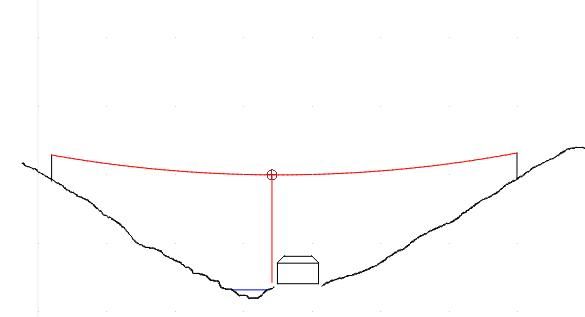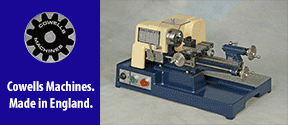MEW Workshop Tales Artie Moore and Titanic
| julian atkins | 17/06/2023 09:41:36 |
1285 forum posts 353 photos | I have been very kindly sent the MEW Workshop Tales article concerning Artie Moore from I presume MEW June 2023. I live only a couple of miles from Gelligroes Mill where Artie grew up. The above article contains no named author or references, and I wonder if these could be provided on here or by PM for my own interest. I have a number of queries:- 1. The article refers to Artie winning a competition in ME. The only competition I am aware of in 1909 was the second ME exhibition, and there is no reference in the exhibition report to Artie Moore or any prize of a book by Sir Oliver Lodge. Re Titanic 2. "assumed the signal was from another ship or land based station". Either Artie knew Titanic's call sign or not! 3. "notified his father who was also a wireless operator". There is no evidence whatsoever that Artie's father was either notified at the time (it was around 3am on a Monday morning) or that Henry Charles Moore (father) held a licence for wireless or ever used his son's wireless telegraphy set. 4. "Together they worked to boost the signal". My knowledge of wireless telegraphy is limited, but there is nothing I gather that could be done to 'boost' receipt of the signal. 5. The article claims a "subsequent role in relaying the distress signals to other ships and authorities" and "this caught the attention of the Marconi Company". Artie's own Post Office licence was limited, and there is no evidence that Artie transmitted to other ships or authorities. 6. There is no evidence that Marconi ever visited Artie Moore at Gelligroes Mill. 7. Artie Moore's subsequent employment with the Marconi Company had nothing to do with anything Titanic related. It had everything to do with him studying at and passing his examinations for his Post Master General's certificate at the British School of Telegraphy in Clapham which examinations he succeeded in April 1912. Indeed, there is the possibility he was still in London at the time Titanic sank. Cheers, Julian Atkins
|
| Dave Halford | 17/06/2023 10:24:21 |
| 2536 forum posts 24 photos | Other links for the Mill only talk of a home built receiver and and that Artie notified the Police. This link suggests that the Titanic spark- gap radio set needed 5 KW and even though the Mill had a generator run off the waterwheel for battery charging it's hard to see how any of point 5. could be true. |
| Hopper | 17/06/2023 10:29:28 |
7881 forum posts 397 photos | Other stories on the net have Artie cycling (one-legged, on his homemade counter-balanced bicycle) to the local police station to raise the alarm, only to be told to go back to bed and behave himself. None of the many other stories about it on the net cite sources either, including the BBC and several newspapers etc. Local legend adopted and promoted by the museum that houses his stuff perhaps? Bit like the Wright Brothers and their allegedly not-quite-first planes at the Smithsonian?
Edited By Hopper on 17/06/2023 10:41:21 |
| Ady1 | 17/06/2023 10:43:05 |
6137 forum posts 893 photos | It's probably an urban myth but you can't apply modern "evidence" to the post Victorian period I have sailed with 3rd engineers who never had an official college qualification but were very highly regarded professionals both employed by and paid by companies like BP I have sailed with british citizens who have travelled all over the world with no passport, just a seamans card and a pile of stapled A4 paper which included visas from the USA (so there was no proof he ever left the country even though he'd been at sea for 12 years) And that was just the 1980s It was a very different world, very different |
| SillyOldDuffer | 17/06/2023 12:08:39 |
| 10668 forum posts 2415 photos | Murky stuff! There's more on Artie Moore here, where not quite the same claims are made. The source is given as the book 'Arthur Moore-The Forgotten Spark' by Leighton Smart GW0LBI. Leighton's contact details are provided. 2. "assumed the signal was from another ship or land based station". Either Artie knew Titanic's call sign or not! That may be unfair. I'm not sure what the CQD procedure was, but later SOS signals were repeated by all the ships and shore-stations who heard them. The purpose was to spread the word so that anyone nearby who missed the original call could react. At the time of the Titanic sinking most ships did not have wireless, or didn't operate a 24 hour watch. So lots of similar signals flying about. More confusion because call signs and procedure abbreviations were less standardised, for example the Titanic was MGY, where M stood for Marconi. As most ships in 1912 were Marconi equipped and operated, it was common practice to drop the M. Another issue was what morse code sounded like. Not the clean audio beeps we associate with Morse Code today - that came later. In 1912 many receivers used a coherer, which produces clicks. Two clicks close together are a dot, and two clicks farther apart are a dash. Messages are decoded from the clickity-click rhythms making up characters and words, and the rhythm is disturbed by natural static (lightening), and by other morse signals. In 1912 receivers and transmitters were both broad, and the best filter an operator had was between his ears. Spark telegraphy was a seriously difficult to acquire skill, easy to get wrong unless conditions were good. Equipment broadness may not have been all bad. In 1901 Marconi proved long distance radio was possible by transmitting the letter S across the Atlantic, but it shouldn't have worked, and it's proved almost impossible to get the same result with modern equipment. The explanation I like is that early transmitters and receivers sent and received high frequency harmonics as well as the fundamental signal, and a harmonic crossed the Atlantic by bouncing off the ionosphere. (A possibility unknown in 1901 but thoroughly researched and exploited by Marconi later.) So what exactly could be received in the UK during the Titanic sinking is difficult to pin down. One thing in Artie's favour is his antenna - a large installation strung across a valley, not a bit of wire in the garden! 4. "Together they worked to boost the signal". My knowledge of wireless telegraphy is limited, but there is nothing I gather that could be done to 'boost' receipt of the signal. Not nothing, particularly if two or more antenna are available. Wires have directional properties, so it's possible to select and combine antenna outputs for best reception by maximising the signal whilst minimising interference. The sensitivity and recovery time of a coherer can be adjusted to filter out some of the muck, as tweaking can the sensitivity of the headphones. Possibly the installation had some form of pre-selector tuning too. Simple by modern standards, but a good operator had plenty of opportunity to improve results. When I experimented with a coherer, it was difficult to adjust. Though Artie Moore has other well documented achievements, I have to agree with Julian that this could be another example an individual riding a disaster for the glory, maybe by piecing together what happened from repeats rather than hearing the actual Titanic. Marconi certainly banged the drum, because it was very much to his advantage for all ships to be legally required to fit radios. As it was to everyone else in the trade, plus radio operators became rock-star status celebrities! Many politicians used the disaster to progress their careers. In terms of what really happened, the US enquiry was badly flawed and the UK Board of Trade Enquiry was imperfect too. Many fibs, exaggerations, gaps, misunderstandings, contradictions, and jumping to conclusions that suited a vested interests. Still going on! Caught out today, the guilty party lies repeatedly and denies everything, whilst loyal supporters cynically endorse falsehoods galore. It seems many people don't value the truth unless it suits them. Dave |
| Hopper | 17/06/2023 13:11:06 |
7881 forum posts 397 photos | Posted by SillyOldDuffer on 17/06/2023 12:08:39:
Murky stuff! There's more on Artie Moore here, where not quite the same claims are made. The source is given as the book 'Arthur Moore-The Forgotten Spark' by Leighton Smart GW0LBI. Leighton's contact details are provided. Which book was published in 2006 by the Arthur Moore Amateur Radio Society and is 8 pages long. Sounds like Leighton Smart is/was a society member. I wonder if the book includes sources? Or is it based on local oral history? There is a copy in the British Library at St Pancras but I am unable to access it from here.
|
| julian atkins | 17/06/2023 14:15:38 |
1285 forum posts 353 photos | I have a copy of Leighton Smart's booklet 'The Forgotten Spark'. There is a copy in the reference section of my local Blackwood library. The Daily Sketch ran a front page article with pics about Artie in it's Saturday 7th October 1911 edition. Artie's obituary appeared in the Merthyr Express newspaper of 5th February 1949 (he died in Bristol on 20th January 1949). I have a copy of the obituary. Headline "He Picked Up Titanic S.O.S." The only line in the obituary mentioning Titanic is "In 1912 he picked up the S.O.S. message of the Titanic in the Atlantic when the Carpathia rushed to the rescue". No other details, although the obituary is quite lengthy and detailed. Nothing about him coming to the attention of Marconi due to anything relating to Titanic, and no mention of a visit by Marconi to Gelligroes. Both articles are mentioned in Leighton Smart's booklet. There is no reference to an article Artie himself wrote for ME published in it's 16th December 1909 edition, describing his own horizontal steam engine with a photo of it. The results of the 1909 ME exhibition appeared in the 11th November 1909 edition of ME. I still have a lot of contemporaneous newspaper research to conduct, and going through microfiche rolls is not much fun, and trying to prove a positive from a negative is not ideal. However, the only Titanic reference I have found is in the above obituary of 1949 - nothing earlier so far. There was a lot of newspaper coverage of Artie in the last week of September 1911 and the above Daily Sketch article, but they pre-date by over 6 months the sinking of Titanic. The glass plate negatives of the pics used in the Daily Sketch (plus others not used) have subsequently been discovered and are available online. They are excellent photographs providing a lot of detail of the aerial hanging from a tree, and the inside of Artie's wooden shed showing his wireless telegraphy set. It is perhaps worth noting that Gelligroes Mill is at the bottom of the Sirhowy Valley (where the Sirhowy river is) and is bordered by 'mountains'/hills at that point some 300 feet high. I get very poor radio reception, and ordinary television reception has to be provided by a relay station. Thank you to those who have taken the trouble to post so far. Some very interesting replies! Edited By julian atkins on 17/06/2023 14:21:24 |
| Michael Gilligan | 17/06/2023 14:16:46 |
23121 forum posts 1360 photos | After several trips to the Tip and a light lunch … I thought I would test my Google Fu **LINK** https://gelligaerhistoricalsociety.co.uk/publications/ Lists Vol. 22 as being available at a modest price … I don’t know if it contains the full text, but I feel quite sure they would be happy to advise. MichaelG. . Post crossed with Julian’s … so probably superfluous. Edited By Michael Gilligan on 17/06/2023 14:21:42 |
| Ady1 | 17/06/2023 14:37:13 |
6137 forum posts 893 photos | Urban myths are often lots of dead ends on the internet The Adolf Hitler/Jesse Owen handshake has had lots of internet copy which basically tells you nowt but... Eric Winkle Brown saw it happen, and that's all the proof I need |
| Redsetter | 17/06/2023 18:51:54 |
| 239 forum posts 1 photos | Can I suggest that a posting on the UK Vintage Radio forum would be worthwhile? They are a very helpful and knowledgeable bunch. |
| julian atkins | 17/06/2023 21:26:30 |
1285 forum posts 353 photos | My cousin John R Sully is a former secretary of the British Vintage Wireless Society, and he knows nothing about this. My cousin is particularly interested in early radio, not wireless telegraphy using morse code. My issue is that an article has been printed in MEW without any author being stated and no references quoted. I think we ought to expect better of ME/MEW when at least some of the relevant details should be in the ME archives? As I have quoted and referenced from 1909 thanks very much to one particular forum member who responded straight away with copies of the relevant MEs of 1909. I don’t expect the anonymous author of the article in MEW to go to the Gwent Archive at Ebbw Vale as I have done, but I would expect some research to have been undertaken, and if only cursory, to be quoted as a source for such an article. Cheers, Julian
Edited By julian atkins on 17/06/2023 21:34:56 |
| julian atkins | 17/06/2023 23:30:22 |
1285 forum posts 353 photos | On 22nd September 1911, the Monmouthshire Higher Education sub committee agreed to provide Artie Moore with a bursary of £35 for instruction in wireless telegraphy. To report as to the institution in which Mr Moore could best study. This decision was reported in the press in the South Wales Gazette on 6th October 1911. I have examined and read for myself the above minutes of the Monmouthshire Higher Education sub committee minutes of 22nd September 1911 thanks to the Gwent Archive at Ebbw Vale. Ref CEM/7 V004196. And much else besides. 13th December 1911 the same committee agreed to pay the bursary to Artie Moore to attend the British School of Telegraphy with an additional £5 for tuition in mathematics. 19th April 1912 Report of the Director of Higher Education That [inter alia] Mr A E Moore has passed the Government Examination of Competency in Wireless Telegraphy.
Edited By julian atkins on 17/06/2023 23:32:58 Edited By julian atkins on 17/06/2023 23:34:28 Edited By julian atkins on 17/06/2023 23:45:34 Edited By julian atkins on 17/06/2023 23:46:06 Edited By julian atkins on 17/06/2023 23:50:15 |
| duncan webster | 17/06/2023 23:59:36 |
| 5307 forum posts 83 photos | Posted by julian atkins on 17/06/2023 21:26:30:
.......... My issue is that an article has been printed in MEW without any author being stated and no references quoted. I think we ought to expect better of ME/MEW when at least some of the relevant details should be in the ME archives?........ Cheers, Julian
Edited By julian atkins on 17/06/2023 21:34:56 I don't consider articles in ME/MEW to be peer reviewed as in scientific journals, the editors can only print what contributors send in. I do agree however that not having an author name, even a pseudonym is a bit odd. Perhaps Julian could put the record straight in 'scribe a line'. The readership of that will probably overlap with the original article better than posts on here, not that I'm suggesting Julian should not post here, certainly got my interest and sent me back to the original. Edited By duncan webster on 18/06/2023 00:03:53 |
| William Howcroft | 18/06/2023 08:03:28 |
| 12 forum posts | https://mc0mnx.webs.com/ |
| Weary | 18/06/2023 09:42:15 |
| 421 forum posts 1 photos | Re: the 'prize' book supposedly awarded in recognition of Mr Moor's model mill engine: "Modern Views of Electricity and Magnetism" by (Sir) Oliver Lodge. I cannot find the quoted title amongst Sir Oliver Lodge's listed publications. Though this is by no means an exhaustive list. However, my internet search has failed to turn up any book with the full title "Modern Views of Magnetism and Electricity" by Oliver Lodge as quoted in all the sources about Mr A Moore. I assume that the book referred to is 'Modern Views of Electricity' by Sir Oliver Lodge, published 1889. Last reprinted 1892, and then far more recently, 2021, as a curiosity. If this is the book referred to then, despite the contents re: storage and generation of electricity perhaps remaining current (pun unintentional!) as basic methods for some years, surely it would have been a little out of date to be awarded as a 'prize' in 1909 or thereabouts, being 20 years old by this time. However, during Mr Moore's youth it may have been useful. This 'prize book' regularly quoted in the printed sources about Mr Moore's life seems to me to be yet another piece of confusion (and perhaps embellishment) in the detail of his undoubtedly interesting life. Given Mr Atkin's researches and discoveries that he mentions above which disprove key elements of the oft-recited tale of A Moore's life it is interesting to speculate who had anything to gain by embellishing the story and why they may have done-so. Phil Edited By Weary on 18/06/2023 09:47:04 |
| Hopper | 18/06/2023 11:07:47 |
7881 forum posts 397 photos | Julian, have you tried tracking down the author of the quoted book, Leighton Smart? He is most likely a local person in the area. Maybe through the Artie Moore Amtr Radio Assc? Or the online whitepages? PS : A quick Google of his name and and "radio wireless" reveals he was a contributor to Practical Wireless magazine in the 1990s. He gave his contact details then as Leighton Smart GWOLBI, (GWOLBI is his radio call sign) 33 Nant Gwyn, If he is still around after all these years, he might divulge his sources for the booklet he authored. PDFs of his column are posted on WWW. worldradiohistory.com but there seems to be no mention on that site of Artie Moore. Perhaps he was bigger figure in Mid Glamorgan than in the overall history of world radio.
Edited By Hopper on 18/06/2023 11:14:44 |
| julian atkins | 18/06/2023 13:24:15 |
1285 forum posts 353 photos | Hi ‘Hopper’, And thank you for the interest you have shown and your posts. I think it is unfair to sort of ‘home in’ on Leighton Smart’s booklet on Artie Moore from 2006 (He also did an article for Practical Wireless the year before). He didn’t have access then to a lot of primary source evidence, and according to a friend of mine who phoned him up about all this last week he principally relied on the Merthyr Express newspaper obituary of 1949. The BBC were broadcasting stuff about Artie Moore and Titanic in the 1990s. None of it referenced or properly researched. My point however is that in the recent MEW article, claims are made which I have itemised in my first post of this thread that have no evidence to back them up whatsoever and are novel and new. That is what particularly concerns me. No author stated, no references, and going way beyond what has previously been stated in print. I would very much appreciate Neil Wyatt to comment as to the anonymous author of this article. Either on this thread or by PM.
Edited By julian atkins on 18/06/2023 13:30:36 |
| Ady1 | 18/06/2023 13:47:39 |
6137 forum posts 893 photos | SOD sums up a lot of the things that went on back then which are never considered nowadays Serious radio hams were always a pretty unique bunch Any rehashing of old info will never prove or disprove anything concrete, it will simply add another layer of mebbe aye mebbe naw |
| SillyOldDuffer | 18/06/2023 14:23:34 |
| 10668 forum posts 2415 photos | Posted by julian atkins on 17/06/2023 14:15:38: ... The glass plate negatives of the pics used in the Daily Sketch (plus others not used) have subsequently been discovered and are available online. They are excellent photographs providing a lot of detail of the aerial hanging from a tree, and the inside of Artie's wooden shed showing his wireless telegraphy set. It is perhaps worth noting that Gelligroes Mill is at the bottom of the Sirhowy Valley (where the Sirhowy river is) and is bordered by 'mountains'/hills at that point some 300 feet high. I get very poor radio reception, and ordinary television reception has to be provided by a relay station. ...Excellent work Julian! Going back to the archives is proper dedication! Artie Moore's aerial and its location are important, because a short length of wire strung in a tree wouldn't have collected enough energy to trigger a coherer unless the transmitter was nearby. The Titanic (and other ships) transmitted on two 'waves': 600metres and 300metres long. 600metre for long range, 300metres over shorter distances. The smallest efficient antenna is a ¼ wave with a good earth, ideally a 150metre tall vertical. (About 500ft high.) The first requirement then is for a lot of space and a good earth. I think Gelligroes Mill provided both. It's located in a wet valley bottom, and it would have been easy to get permission to put masts up and run wires over adjacent land - agricultural, maybe wild. A 150 metre tall antenna is serious engineering! But the mountains provide height, albeit with screening. Also, although it increasingly reduces efficiency, it's possible to reduce the size of an antenna by loading it capacitively and/or inductively. So Artie had the opportunity to erect an efficient long wave aerial, something like this T-antenna: Most of the radiation is off the vertical section, which is connected to a good earth at the bottom. Wet alluvial soil at or near a stream is much better than the top of a rocky mountain. Although the horizontal top of the T is made of wire and might be assumed to be an inductor, it mostly puts a largish capacitance between earth and the top of the vertical section. At the time this was a well-known configuration, usually implemented on a smaller scale on ships by suspending the T between the masts and dropping the vertical to a radio shack behind the bridge: I think the Titanic had a T-antenna, in her case the excellent earth being provided by the sea. Usually long wave transmitting stations were located on flat ground so the antenna had a clear take-off. But I don't think mountains are quite the brick-wall at long-wave that they are to high frequency signals. Criggion Radio Station was located in a deep Welsh valley between mountains. It transmitted to submerged submarines on Very Long Wave (about 18000metres). I guess the height of the mountains and low cost of land made it cheaper and easier to build the very large antenna needed. Remote mountain valleys are also electrically quiet - no VFD powered lathes for miles! Grimeton Radio Station in Sweden is operational on special occasions, transmitting on 17400metres with an Alexanderson Generator, no electronics. Most impressive. The antenna is is over 2km long and strung between six 127metre high towers, on flat ground near the coast. It's too small to be efficient... Even though the Gelligroes Mill area must have awful reception today, I think was a good site for receiving Atlantic ship-shore radio signals in 1912. Not ideal, but much better than most locations. Not many places in England with the same opportunity for an affordable installation. 1912 was the first year that triode valves were used to amplify radio signals by anyone, making it very unlikely that Artie Moore had that technology. To hear the Titanic his receiver needed a really good antenna, and it's possible Gelligroes Mill provided what was needed for him to erect one without costing a fortune. Dave
Edited By SillyOldDuffer on 18/06/2023 14:27:21 |
| Redsetter | 18/06/2023 14:53:59 |
| 239 forum posts 1 photos | Stating the obvious perhaps, but the editor of MEW must know the source of the article. Maybe ask nicely?
|
Please login to post a reply.
Want the latest issue of Model Engineer or Model Engineers' Workshop? Use our magazine locator links to find your nearest stockist!
Sign up to our newsletter and get a free digital issue.
You can unsubscribe at anytime. View our privacy policy at www.mortons.co.uk/privacy
- hemingway ball turner
04/07/2025 14:40:26 - *Oct 2023: FORUM MIGRATION TIMELINE*
05/10/2023 07:57:11 - Making ER11 collet chuck
05/10/2023 07:56:24 - What did you do today? 2023
05/10/2023 07:25:01 - Orrery
05/10/2023 06:00:41 - Wera hand-tools
05/10/2023 05:47:07 - New member
05/10/2023 04:40:11 - Problems with external pot on at1 vfd
05/10/2023 00:06:32 - Drain plug
04/10/2023 23:36:17 - digi phase converter for 10 machines.....
04/10/2023 23:13:48 - More Latest Posts...
- View All Topics
- Reeves** - Rebuilt Royal Scot by Martin Evans
by John Broughton
£300.00 - BRITANNIA 5" GAUGE James Perrier
by Jon Seabright 1
£2,500.00 - Drill Grinder - for restoration
by Nigel Graham 2
£0.00 - WARCO WM18 MILLING MACHINE
by Alex Chudley
£1,200.00 - MYFORD SUPER 7 LATHE
by Alex Chudley
£2,000.00 - More "For Sale" Ads...
- D1-3 backplate
by Michael Horley
Price Not Specified - fixed steady for a Colchester bantam mark1 800
by George Jervis
Price Not Specified - lbsc pansy
by JACK SIDEBOTHAM
Price Not Specified - Pratt Burnerd multifit chuck key.
by Tim Riome
Price Not Specified - BANDSAW BLADE WELDER
by HUGH
Price Not Specified - More "Wanted" Ads...
Do you want to contact the Model Engineer and Model Engineers' Workshop team?
You can contact us by phone, mail or email about the magazines including becoming a contributor, submitting reader's letters or making queries about articles. You can also get in touch about this website, advertising or other general issues.
Click THIS LINK for full contact details.
For subscription issues please see THIS LINK.
Model Engineer Magazine
- Percival Marshall
- M.E. History
- LittleLEC
- M.E. Clock
ME Workshop
- An Adcock
- & Shipley
- Horizontal
- Mill
Subscribe Now
- Great savings
- Delivered to your door
Pre-order your copy!
- Delivered to your doorstep!
- Free UK delivery!











 Register
Register Log-in
Log-in


